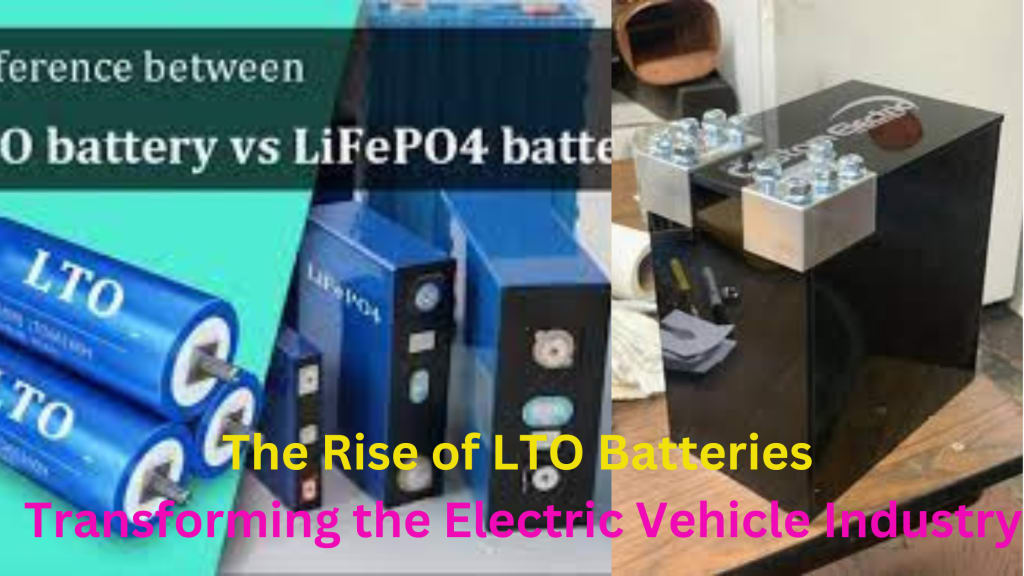The Rise of LTO Batteries
Transforming the Electric Vehicle Industry

The Rise of LTO Batteries Transforming the Electric Vehicle Industry
Introduction:
Elon Musk's recent announcement about the skyrocketing price of lithium on Twitter has created a buzz in the industry. With prices reaching insane levels, Tesla might be compelled to venture into mining and refining lithium directly. As the global battery demand continues to explode, reaching an estimated 603 gigawatt-hours, Tesla has big plans to meet the needs of the massive market. One battery technology that is gaining attention is the lithium titanate (LTO) battery, known for its fast charging capabilities and extended life cycle. In this article, we will explore the significance of LTO batteries and their role in transforming the electric vehicle (EV) industry.
Lithium Titanate Battery: A Game-Changing Technology
The LTO battery, with the chemical formula Li2TiO3, utilizes lithium titanate as its anode material. This rechargeable battery offers several advantages over other lithium-ion batteries, such as faster charging and a longer life cycle. Its pricing advantage is evident when compared to lithium iron phosphate (LiFePO4) batteries. The LTO battery is approximately $10 cheaper per unit at the same voltage and offers additional savings when used in electric vehicles.
Extended Life Cycle and Durability
One standout feature of LTO batteries is their impressive life cycle, surpassing thirty thousand cycles. This is 60 times more than competitive lithium-ion technology like lead-acid batteries. The longevity of LTO batteries extends up to 82 years, making them highly durable and reliable. Tesla recognizes the value of these long-lasting batteries and plans to incorporate them into their products.
Tesla's Vision and Investment in LTO Batteries
Elon Musk acknowledges the rising price of lithium and aims to address the future battery demand by conducting research, exploration, and manufacturing of batteries. Tesla's investment of billions of dollars in building its own battery manufacturing facilities in Nevada reflects its commitment to battery technology. By combining lithium and titanium materials, Tesla aims to reduce costs and improve battery quality, making LTO batteries an integral part of their plans.
Advantages of LTO Batteries in Charging and Discharging
LTO batteries excel in rapid charging, capable of fully charging in just 10 minutes. This makes them an ideal choice for high-speed charging applications. Unlike other lithium-ion batteries, LTO batteries have a charge and discharge conversion efficiency of up to 86% and exhibit superior performance in a wide temperature range. Their unique anode composition and higher lithium-ion diffusion coefficient enable quick charging and discharging without compromising safety.
Production and Construction of LTO Batteries
LTO batteries are produced using cutting-edge technology and consist of an anode made of lithium titanate nano-crystals. The battery cells have a cylindrical shape similar to other Tesla batteries but are larger in size. These cells can be connected to form battery packs with customized configurations based on specific requirements. The safety features of LTO batteries make them a reliable option for various applications.
Safety and Reliability of LTO Batteries
One of the key advantages of LTO batteries is their enhanced safety and reliability. The use of lithium titanate as the anode material significantly reduces the risk of thermal runaway and related safety issues commonly associated with other lithium-ion batteries. LTO batteries are less prone to overheating and have a higher tolerance for overcharging or discharging. These features make them a preferred choice for applications where safety is a top priority, such as electric vehicles and energy storage systems.
LTO Batteries and Electric Vehicle Adoption
The rapid charging capabilities of LTO batteries have a direct impact on the adoption of electric vehicles. Long charging times have been one of the major concerns for EV owners, often cited as a barrier to widespread adoption. With LTO batteries, the charging time can be significantly reduced, making electric vehicles more convenient and comparable to traditional gasoline-powered vehicles in terms of refuelling time. This breakthrough technology has the potential to revolutionize the EV industry and accelerate the transition to a sustainable transportation system.
LTO Batteries in Energy Storage Systems
Beyond electric vehicles, LTO batteries also find applications in energy storage systems. The ability to charge and discharge quickly, coupled with their long cycle life and safety features, make them suitable for stationary storage solutions. LTO batteries can help stabilize the electrical grid, store excess renewable energy, and provide backup power during peak demand periods. As the demand for renewable energy continues to grow, LTO batteries can play a crucial role in optimizing its utilization and ensuring grid reliability.
Challenges and Future Outlook
While LTO batteries offer several advantages, they are not without their challenges. The higher cost compared to traditional lithium-ion batteries and the relatively lower energy density are areas that need further improvement. However, ongoing research and development efforts aim to address these limitations and optimize the performance of LTO batteries. As technology advances and economies of scale kick in, it is expected that the cost of LTO batteries will reduce, making them more competitive in the market.
Looking ahead, the future of LTO batteries appears promising. Their unique combination of fast charging, extended life cycle, safety, and reliability positions them as a transformative force in the electric vehicle and energy storage industries. With Tesla's significant investment and other manufacturers exploring the potential of LTO batteries, we can expect to see wider adoption of this technology, driving the next phase of growth and innovation in the clean energy sector.
Safety and Reliability of LTO Batteries
One of the key advantages of LTO.Exploring New Frontiers: LTO Batteries in Emerging Applications
While LTO batteries have already made significant strides in electric vehicles and energy storage, their potential reaches far beyond these industries. Researchers and innovators are exploring new frontiers where LTO batteries can bring unique benefits and advancements. Let's delve into some of these emerging applications:
Aerospace and Aviation: The aerospace industry is known for its rigorous safety standards and requirements. LTO batteries' inherent safety features make them an attractive choice for aircraft systems, including electric propulsion, emergency power backup, and auxiliary power units. Their fast-charging capability can also reduce downtime between flights, enhancing operational efficiency.
Marine and Maritime: LTO batteries' ability to withstand harsh environmental conditions, their safety, and their long cycle life make them well-suited for marine and maritime applications. From electric boats and yachts to offshore renewable energy platforms, LTO batteries can provide reliable and efficient power storage solutions for extended periods at sea.
Portable Electronics: While LTO batteries have lower energy density compared to traditional lithium-ion batteries, their advantages in terms of safety and durability make them an interesting option for certain portable electronic devices. For instance, LTO batteries can be used in medical devices, ruggedized equipment, and industrial tools where safety and longevity are paramount.
Grid-Scale Energy Storage: As the demand for renewable energy continues to rise, grid-scale energy storage solutions become crucial for balancing intermittent energy sources. LTO batteries' rapid charge and discharge capabilities, coupled with their extended cycle life, make them well-suited for large-scale energy storage installations. These batteries can help stabilize the grid, support load shifting, and enhance overall grid reliability.
Defence and Military Applications: The defence sector requires advanced energy storage solutions for various applications, including soldier equipment, unmanned systems, and microgrids. LTO batteries' safety, durability, and ability to operate in extreme conditions make them a viable option for these demanding environments, ensuring mission-critical power supply and reducing logistical challenges.
Smart Grid and Microgrid Integration: LTO batteries can play a significant role in the integration of smart grids and microgrids. Their fast response time, high power density, and long cycle life enable efficient energy management, load balancing, and peak shaving. This technology empowers communities and industries to optimize their energy usage, reduce costs, and enhance resilience in the face of power outages or natural disasters.
As LTO batteries continue to evolve and research progresses, we can expect further advancements and innovations in these emerging applications. The versatility, safety, and reliability of LTO battery technology position it as a key player in shaping a sustainable and electrified future across multiple industries.
Conclusion
LTO batteries, with their fast charging capabilities, extended life cycle, safety features, and durability, have the potential to revolutionize the electric vehicle and energy storage industries. Tesla's investment in LTO battery manufacturing reflects its confidence in this technology. As costs continue to decrease and performance improves, LTO batteries will play a pivotal role in accelerating the adoption of electric vehicles, enabling convenient and sustainable transportation. Additionally, their application in energy storage systems will contribute to grid stability and the integration of renewable energy sources. The rise of LTO batteries marks an exciting chapter in the industry's transformation towards LTO batteries have already demonstrated their prowess in electric vehicles and energy storage systems, revolutionizing these industries with their fast charging capabilities and enhanced safety. However, the potential of LTO batteries goes beyond these applications. From aerospace and marine sectors to portable electronics and grid-scale energy storage, LTO batteries are finding their way into a wide range of emerging applications. As research and development efforts continue, we can anticipate further improvements, cost reductions, and performance optimizations in LTO battery technology. This progress will drive the adoption of LTO batteries in new industries, accelerating the transition to a cleaner and more sustainable future.
About the Creator
Riaz Sharif
I am soft-spoken person, like a "Gentle Scholar" I am trying always to enable effective interaction with others. My passion is continuous learning and personal growth, which drives me to constantly seek new knowledge and experiences.
Enjoyed the story? Support the Creator.
Subscribe for free to receive all their stories in your feed. You could also pledge your support or give them a one-off tip, letting them know you appreciate their work.






Comments
There are no comments for this story
Be the first to respond and start the conversation.